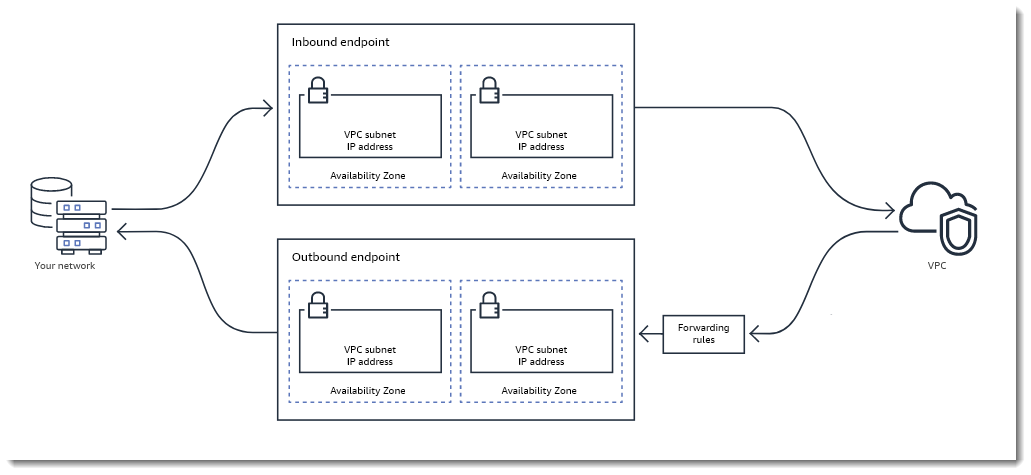Route 53 & Route 53 Resolver connecting people
Tools that are available in AWS cloud and allow you to direct users to your web application are Amazon Route 53 and Amazon Route 53 Resolver.
Amazon Route 53 is a network service – a DNS (Domain Name System) service that easily deals with resolving domain names and subdomains (e.g. www.example.com) to numeric IP addresses. With Route 53, an AWS console user can register a domain name. With this option, you can freely buy and manage your domains, and the service will automatically configure DNS settings.
Amazon Route 53 is also the answer to how to effectively combine users’ requests with infrastructure based on AWS. These include Amazon EC2 instances or load balancers, but also Amazon S3 buckets.
The service can also be used to verify health of your application. If any of the endpoints has been damaged, the service directs traffic to healthy ones.
Amazon Route 53 Resolver is a solution that by default responds to DNS requests related to VPC domain names. It is adapted to the requirements (conditions) of hybrid clouds. It is a set of functions that allow two-way sending of queries between local and AWS instances through private connections. To do this, you should use the AWS Direct Connect service or VPN configuration.
What features of Amazon Route 53 Resolver are worth noting?
- Route Resolver Endpoints – this feature allows local resources to solve names set on the AWS cloud side in Route 53. Connectivity between the local “on-premise” environment and the AWS cloud environment is determined directly by a Direct Connect connection (DX) or via a virtual private network (VPN). Endpoints are configured by assigning IP addresses in the subnets for which you want to run the resolver.
- Conditional forwarding rules – this functionality allows you to configure hosted domains in your local DNS infrastructure as pass rules in Route 53 Resolver. As with incoming queries, this feature requires a private connection configuration via DX or VPN. Combining these two options enables recursive DNS lookups for hybrid environments. This allows you to save on managing, supporting and maintaining an additional DNS infrastructure while working in both environments.

Scheme: Conditional transfer rules
There are several advantages of using the services:
- They’re highly available and reliable – the distributed nature of DNS servers helps to ensure the constant possibility of targeting end users to the application.
- They’re designed for use with other AWS services..
- They’re cost-effective, mainly because of the possibility of benefits from the AWS scale. Fees are charged only for the resources used, such as the number of queries that services support each domain or hosted zones for domain management through services.
- They’re easily scalable. Both services have been designed for automatic scaling to handle very large volumes of queries, without any intervention from the user.
- They’re safe. By integrating with AWS Identity and Access Management (IAM), you can grant unique credentials and manage permissions for each user in the AWS account and specify who has access to individual parts of the Route 53 and Route 53 Resolver services.
- They’re simple solutions for a hybrid cloud. Amazon Route 53 Resolver provides recursive DNS for Amazon VPC and local networks via AWS Direct Connect or AWS managed by VPN.
In terms of costs, it is worth to check the pricing published by AWS. The price depends on, among others:
- hosted zones,
- queries
- query aliases,
- traffic flow to www,
- and others.
There are many possibilities. Mentioned services allow you to choose solutions to your needs. It is worth noting that fees are charged for the used resources, which is an undeniable advantage.
Amazon Route 53 and Amazon Route 53 Resolver streamline the traffic management process. Both services are secure and compatible with other AWS services. They help ensure smooth operation of domains using the AWS Best Practices
